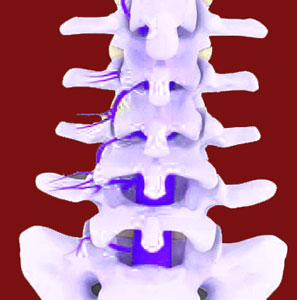
What are facet joints? This is a question posed by many people who are diagnosed with back or neck pain related to joint dysfunction or degeneration. Many people have an idea what the spine looks like, but are not really sure which part is which or what the individual components of the vertebral column actually do. For curious readers, we can provide all the information you need to know about the spinal facet joints.
Let’s start off by saying that facet joints can also be called apophyseal joints or zygapophyseal joints. All these names are synonymous and identify the exact same anatomical structures in the backbone. These structures are located on the rear side (posterior) of the spine, facing outwards towards the skin on the back.
This dialog helps answer the question: “What are the spinal facet joints?” We will provide some easy to understand information that will get you up to speed on all the most important facet joint facts by the time you are finished reading this short discussion.
What are Facet Joints in the Spine?
The spine is a large structure that is made up of many smaller components. There are individual vertebral bones called vertebrae. These bones account for the majority of the mass of the spine and about 75% of it total length. In between the vertebrae reside soft cushions called intervertebral discs. These discs account for about 25% of the total length of the backbone.
The bones and discs are all joined together tightly, but in a configuration that allows movement of each bone, relative to the one above and below it. Where the vertebrae meet are areas called joints. Joints exist all over the body, wherever 2 bones meet. In the spine, there are many joints, each of which has a particular job to perform in order to make the spine work in the almost miraculous way that it does. The facet joints are vital for overall spinal stability and functionality.
Facet joints link the vertebral bones together vertically. In essence, they bond the vertebra to the one above and below in a flexible joining that facilitates a specific range of motion, which varies depending on where in the spine the joint resides. Additionally, the facet joints differ in design from one vertebra to the next, allowing specific parts of the spine to bend, flex and rotate to different degrees than others for truly customized functionality.
Facet Joint Purpose
The facet joints provide several important functional to the backbone:
First, they physically bond the vertebrae together, increasing the overall strength of the spinal column exponentially compared to each vertebral level acting alone. The bond formed between vertebral bones is very strong, yet flexible enough to provide extensive movement in many spinal locations. The facet joints prevent vertebral bones from disconnecting from one another, migrating or otherwise becoming structurally compromised.
Next, the range of movement provided by each joint defines how each area of the spine is designed to function. The cervical spine enjoys the most freedom of movement, with wide ranges of extension, flexion, lateral movement and rotation possible due to very versatile facet connections. The thoracic spine demonstrates very little degree of extension or flexion, yet still can move laterally and rotate a significant amount. The lumbar spine enjoys a substantial ability to extend and flex, as well as move laterally, but has a greatly limited range of rotational motion.
Next, the facet joints help to maintain stability throughout the very extensive range of motion of the human spine. Each facet is organically designed to accommodate a specific range of movement in relation to those around it, providing maximum flexibility and stability when acting in unison with all the other joints in the backbone.
Finally, the facet joints are engineered to provide all of these benefits to the spine safely and without pain. They are well insulated with cartilage and synovial lubricating fluid. Unfortunately, these insulating measures are the first components of the facet joints to suffer the detrimental effects of age and activity. This is called facet joint degeneration.
What are Facet Joints and How Do They Become Painful?
As noted above the facet joints suffer deterioration of form and function, just like the remainder of the spine. Most adults demonstrate facet joint arthritis and hypertrophy past the age of 40, but some show the signs of these changes much younger. Facet joint degeneration is most notable in the cervical and lumbar spines, particularly between C5 and T1 and L4 and S1.
When the facet joints degenerate, the protective synovial fluid dries up and the insulating cartilage wears away. The results include increased friction inciting bone on bone contact, facilitating arthritic formation of osteophytes and accumulating debris in and around the joint. While these processes are completely normal for all humans to demonstrate, some cases may become pathological and these are the instances that are diagnosed as facet joint syndrome.





